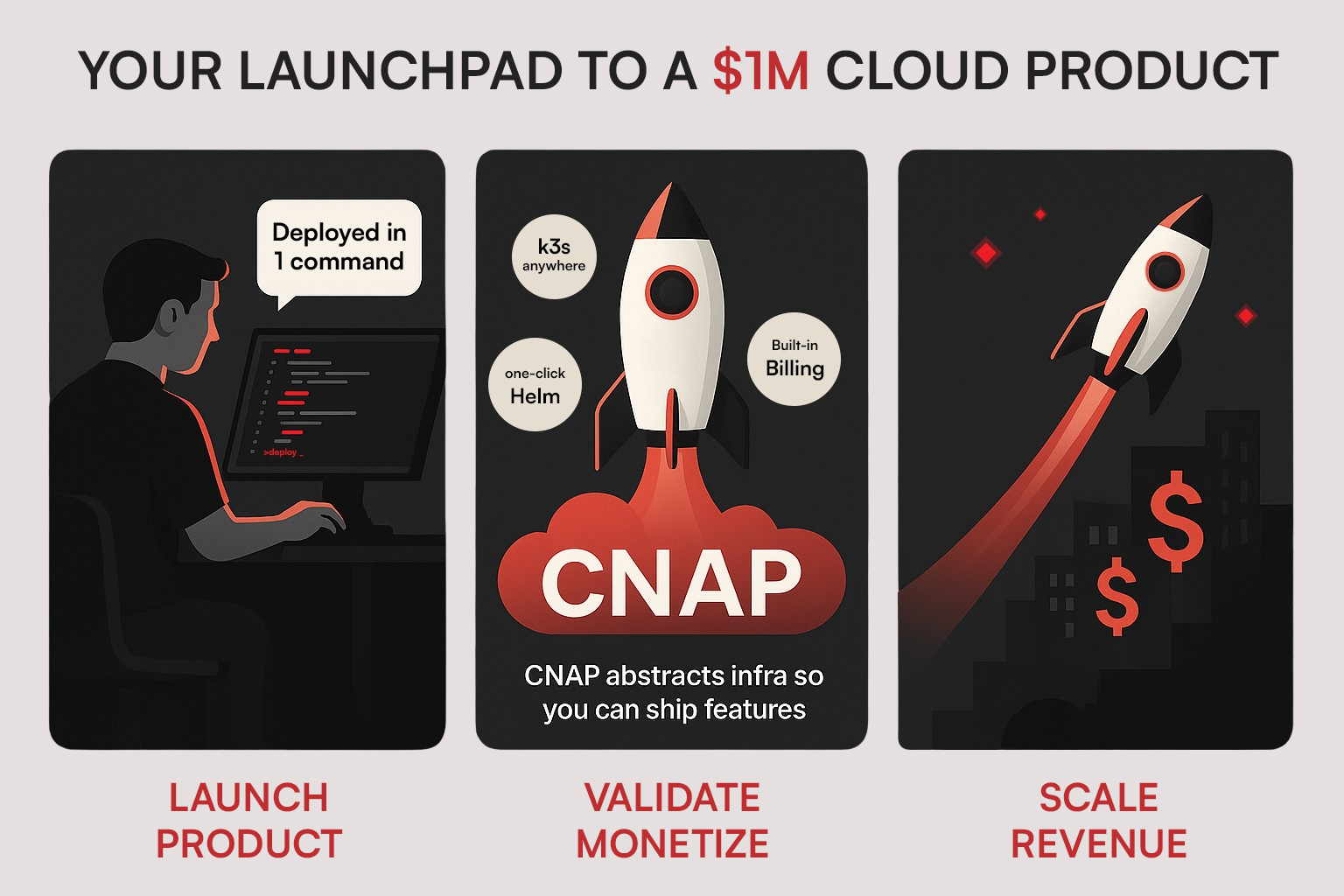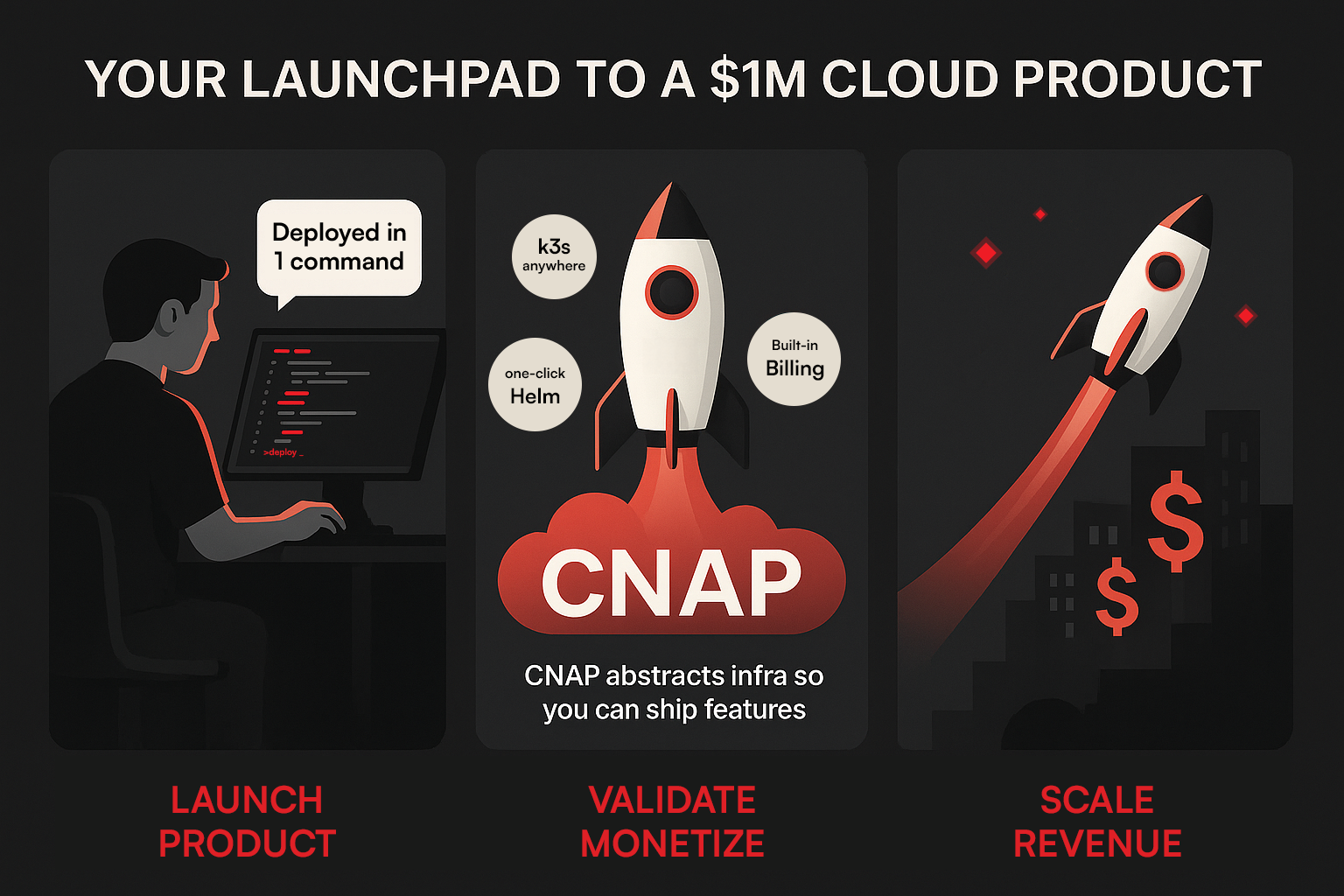
Introduction
This guide is for developers and entrepreneurs who want to build, deploy, and most importantly, sell their cloud applications without drowning in infrastructure complexities.Disclaimer
Disclaimer
The information provided here is for educational purposes. While the
strategies and concepts discussed are aimed at helping you achieve success and
are based on real-world examples, there is no guarantee of specific outcomes.
Success depends on various factors including individual effort, market
conditions, and technical execution. BUILDING A SUCCESSFUL PRODUCT REQUIRES
HARD WORK AND PERSISTENCE.
What is a “cloud-native product”?
Cloud-native product (definition) - a software application built using modern containerized architecture that’s designed to run efficiently in cloud environments. But here’s the reality: your customers don’t care if your product is “cloud-native” or not. They care about the value it provides. Anyone building software products today should leverage cloud-native approaches, but many get stuck in the infrastructure weeds and never ship. Why? Because becoming an expert in Kubernetes, cloud infrastructures, CI/CD pipelines, and security is time-consuming and complex. This is exactly why CNAP exists - to handle the complex cloud-native infrastructure so you can focus on building features your customers will pay for.What we’re going to cover
- Why traditional software deployment is holding back your business
- How successful products win in the cloud-native world
- The fastest path from code to paying customers
- NOT going to cover obscure technical implementation details (that’s what CNAP handles for you)
What successful cloud-native products have in common
There are always exceptions, but in our research, most successful cloud products:1
Focus relentlessly on customer problems, not infrastructure
This is the number one factor across all successful cloud products.Especially for early-stage startups and indie developers.They all spend their time in one (or many) of the following areas:
- Understanding customer pain points: Talking to users and really understanding their problems.
- Building differentiated features: Creating solutions that stand out from alternatives.
- Getting early feedback: Shipping quickly to validate ideas before investing too much time.
- Understanding pain points: Creating a solution that directly addresses a specific workflow bottleneck for target users.
- Building differentiated features: Adding unique capabilities that existing products can’t easily copy.
- Getting early feedback: Releasing an MVP in weeks, not months, to start the learning cycle.
2
Leverage platforms that reduce infrastructure complexity
The most successful products aren’t built by teams that create everything from scratch.Often, these founders stand on the shoulders of giants, using platforms that already solved the hard infrastructure problems.Sometimes, these platforms handle everything from deployment to scaling to security, allowing the founders to focus entirely on their unique value.For example:
- Kubernetes (adopted by 96% of organizations in 2023)
- CI/CD automation (used by 83% of software teams)
- Cloud hosting (powering millions of applications)
Simple Math to Your First Million
10 paying customers x 1,000 MRR → $12K ARR → YOUR FIRST MICRO-SAASThen scale to 100 customers = 120K ARR → LIFE-CHANGING INCOME
3
Start with a simple, focused solution
Successful cloud-native products start with a “pointy” solution - a focused product that solves a specific problem extremely well.In other words, they generally start by doing one thing better than anyone else.Nearly all of the successful products I’ve researched started this way.Instead of building a comprehensive platform, they start with:
- One critical workflow that’s painful for users
- One integration that solves a specific pain point
- One dashboard that provides unique insights
4
Target specific customer segments
In nearly all examples, successful cloud-native products serve a very specific customer.Here’s one example:
- Businesses
- Businesses in the e-commerce space
- Businesses in e-commerce who use specific platforms
- E-commerce businesses who struggle with a particular problem
- Dev teams who need to streamline their release process.
- Marketing agencies who need to manage multiple client websites.
- Financial services companies with specific compliance requirements.
5
Solve painful problems businesses will pay for
All successful products are rooted in solving painful problems.And all painful business problems relate back to two core issues:
- “We’re losing money or missing opportunities.”
- “We’re wasting time on tedious tasks.”
A couple more things worth mentioning
- B2B focus: Products targeting businesses typically generate more revenue with fewer customers than B2C products.
- Price based on value: Most successful cloud-native products charge at least $50-100/month for their base plans, with enterprise tiers reaching thousands per month.
- Consider how you’ll market: Many successful founders build audiences through content marketing, open-source, or community engagement before launching their paid products.
How CNAP helps you build a profitable cloud-native product
CNAP (Cloud Native Application Platform) is specifically designed to help developers like you turn your code into a profitable business with minimal overhead. Here’s how:Focus on your unique value
CNAP handles the underlying infrastructure, deployment pipeline, and
operational complexities.
Get to market faster
Deploy your app in minutes rather than spending weeks setting up Kubernetes
clusters, CI/CD pipelines, and monitoring.
Built-in monetization
CNAP includes the tools to package, price, and sell your software directly
to customers.
Transparent pricing
Let customers see exactly what they’re paying for with clear resource
allocation and costs.
Scale without headaches
As your customer base grows, CNAP handles the increasing infrastructure
demands automatically.
The path to your first profitable cloud product
Now I’m going to walk you through the key steps to go from code to paying customers:1
Package your application
Transform your existing code into a deployable cloud-native product.What it solves: “I’ve built something useful, but it’s hard to distribute and deploy”Core problem: “I can’t turn my code into a real product”.Why CNAP makes this simple:
- Container-based deployment: Package your application once, deploy it anywhere.
- Automated CI/CD: Changes to your code are automatically built and deployed.
- Version management: Maintain multiple versions of your product for different customers.
2
Set up pricing
Determine your pricing strategy and implement it through CNAP’s marketplace.What it solves: “I don’t know how to charge for my software or implement billing”Core problem: “I can’t convert users into revenue”.Why CNAP makes this simple:
- Flexible pricing models: Support for subscription, usage-based, or hybrid pricing.
- Automated billing: CNAP handles invoicing and payment collection.
- Usage tracking: Monitor how customers use your product to optimize pricing.
3
Create and list your product
Use CNAP’s marketplace to make your product available for customers to discover and purchase.What it solves: “It’s difficult to reach customers and create a professional product listing”Core problem: “I need a way to showcase and distribute my solution”.Why CNAP makes this simple:
- Marketplace listing: Create a professional product page with minimal effort.
- Customer-specific deployments: When customers purchase, CNAP automatically deploys your product for each customer.
- Infrastructure abstraction: No need to manage individual customer installations, servers, or networking.
4
Attract your first customers
Leverage documentation, demos, and targeted outreach to get your first users.What it solves: “I’ve built a product but nobody knows about it”Core problem: “I need paying customers to build a business”.Why CNAP helps:
- Marketplace exposure: List your product in CNAP’s marketplace for immediate visibility.
- Easy trials: Let potential customers try your product with minimal friction.
- Shareable deploy links: Create simple links that let prospects deploy your product in seconds.
5
Iterate based on feedback
Continuously improve your product based on customer input.What it solves: “I’m not sure if I’m building what customers actually want”Core problem: “I might waste time on the wrong features”.Why CNAP helps:
- Usage analytics: See how customers interact with your product.
- Quick deployment cycles: Rapidly ship improvements based on feedback.
Real-world success stories
While I could share examples all day, here’s what matters most: developers like you are using platforms like CNAP to bypass the complexities of cloud infrastructure and focus on building products that customers love and pay for. The key is to start small, focus on a specific problem, and leverage platforms that handle the infrastructure complexity for you. My goal with this guide was to help you understand how to transform your code into a profitable cloud-native product without getting bogged down in infrastructure details - now go build and sell your software!If you want to dive deeper, check out the documentation - it has detailed
guides on getting started with CNAP.
Next Steps
Now… it’s time to build, deploy, and sell your product. In the coming weeks, you can take your existing code, deploy it on CNAP, and start acquiring your first paying customers - potentially creating a business that changes your life.Launch Your Product Today!
Get started within minutes.
